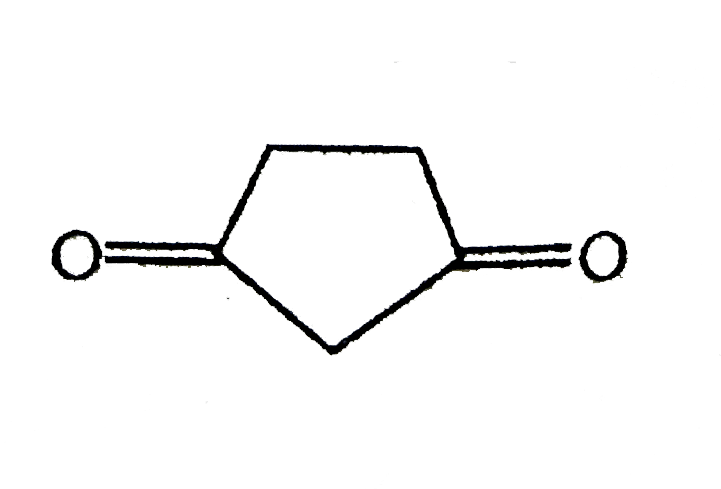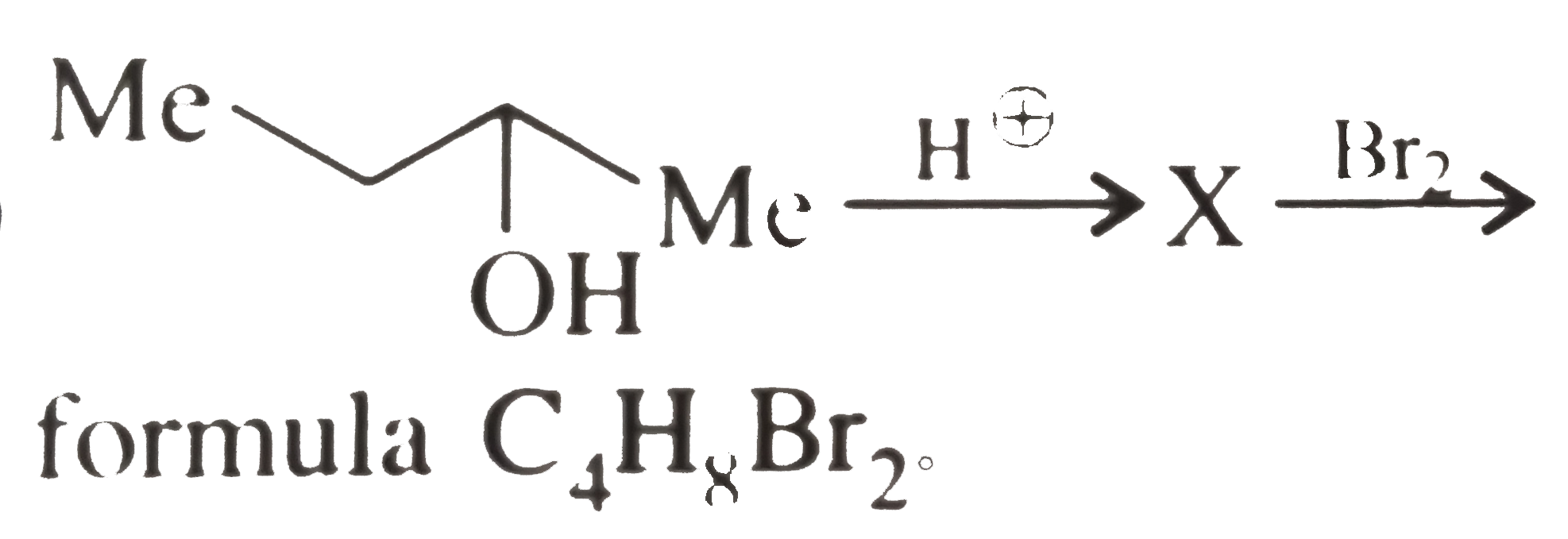A polystryrene, having formula Br3C6H2(C8H8)n, was perpared heating styrene with tribromobenzoyl peroxide in the absence of air. If it was found to contain 10.46% bromine by weight, find the value of n.
To find the value of n in the compound Br3C6H2(C8H8)n that contains 10.46% bromine by weight, we will follow these steps:
Step 1: Write the formula for the percentage of bromine
The percentage of bromine in the compound can be expressed as:
Percentage of Br=Mass of BrMass of compound×100
Step 2: Calculate the mass of bromine in the compound
The mass of bromine in the compound can be calculated from its formula:
- The formula has 3 bromine atoms, and the molar mass of bromine (Br) is approximately 80 g/mol.
Mass of Br=3×80=240 g/mol
Step 3: Calculate the molar mass of the entire compound
The molar mass of the compound can be calculated as follows:
- For C6H2:
Mass of C6H2=(6×12)+(2×1)=72+2=74 g/mol
- For (C8H8)n:
Mass of C8H8=(8×12)+(8×1)=96+8=104 g/mol
Thus, the total mass of the compound is:
Molar mass of compound=240+74+104n=314+104n g/mol
Step 4: Set up the equation using the percentage of bromine
We know that the percentage of bromine is 10.46%. Therefore, we can set up the equation:
10.46=240314+104n×100
Step 5: Solve for n
Rearranging the equation gives:
10.46=24000314+104n
Cross-multiplying gives:
10.46(314+104n)=24000
Expanding this:
3284.84+1086.84n=24000
Now, isolate n:
1086.84n=24000−3284.84
1086.84n=20715.16
n=20715.161086.84≈19.05
Thus, rounding to the nearest whole number, we find:
n≈19
Final Answer
The value of n is approximately 19.
---
The percentage of bromine in the compound can be expressed as:
Percentage of Br=Mass of BrMass of compound×100
The mass of bromine in the compound can be calculated from its formula:
- The formula has 3 bromine atoms, and the molar mass of bromine (Br) is approximately 80 g/mol.
Mass of Br=3×80=240 g/mol
The molar mass of the compound can be calculated as follows:
- For C6H2:
Mass of C6H2=(6×12)+(2×1)=72+2=74 g/mol
- For (C8H8)n:
Mass of C8H8=(8×12)+(8×1)=96+8=104 g/mol
Thus, the total mass of the compound is:
Molar mass of compound=240+74+104n=314+104n g/mol
We know that the percentage of bromine is 10.46%. Therefore, we can set up the equation:
10.46=240314+104n×100
Rearranging the equation gives:
10.46=24000314+104n
Cross-multiplying gives:
10.46(314+104n)=24000
Expanding this:
3284.84+1086.84n=24000
Now, isolate n:
1086.84n=24000−3284.84
1086.84n=20715.16
n=20715.161086.84≈19.05
Thus, rounding to the nearest whole number, we find:
n≈19
The value of n is approximately 19.
Topper's Solved these Questions
- SOME BASIC CONCEPTS AND MOLE CONCEPTBOOK - CENGAGE CHEMISTRY ENGLISHCHAPTER - SOME BASIC CONCEPTS AND MOLE CONCEPTEXERCISE - Ex 1.1 Objective Questions
6 Videos
- SOME BASIC CONCEPTS AND MOLE CONCEPTBOOK - CENGAGE CHEMISTRY ENGLISHCHAPTER - SOME BASIC CONCEPTS AND MOLE CONCEPTEXERCISE - Ex 1.1 Objective Questions (Single Correct)
3 Videos
- S-BLOCK GROUP 2 - ALKALINE EARTH METALSBOOK - CENGAGE CHEMISTRY ENGLISHCHAPTER - S-BLOCK GROUP 2 - ALKALINE EARTH METALSEXERCISE - Ex 5.1 Objective
2 Videos
- STATES OF MATTERBOOK - CENGAGE CHEMISTRY ENGLISHCHAPTER - STATES OF MATTEREXERCISE - Exercises (Ture False)
25 Videos
Similar Questions
The compound having the molecular formula C3H9N can represent
View SolutionAn optically active compound A (assume dextrorotatory) has the molecular formula C7H11Br. A reacts with hydrogen bromide, in the absence of peroxides to yield isomeric products, B and C, with the molecular formula C7H12Br2. Compound B is optically active, C is not. Treating B with 1 mol of potassium butoxide yields (+)−A. Treating C with 1 mol of potassium tert-butoxide yields (±)−A. Treating A with potassium tert-butoxide yields D(C7H10). Subjecting 1 mol of D to ozonolysis followed by treatement with zinc and acetic acid yields 2 moles of formaldehyde and 1 mole of 1,3-cyclopentanedione.

The optically active compound 'A' is
View SolutionAn optically active compound A (assume dextrorotatory) has the molecular formula C7H11Br. A reacts with hydrogen bromide, in the absence of peroxides to yield isomeric products, B and C, with the molecular formula C7H12Br2. Compound B is optically active, C is not. Treating B with 1 mol of potassium butoxide yields (+)−A. Treating C with 1 mol of potassium tert-butoxide yields (±)−A. Treating A with potassium tert-butoxide yields D(C7H10). Subjecting 1 mol of D to ozonolysis followed by treatement with zinc and acetic acid yields 2 moles of formaldehyde and 1 mole of 1,3-cyclopentanedione.

The compound 'B' is:
View SolutionAn aromatic compound 'A' having molecular formula C7H6O2 on treating with aqueous ammonia and heating forms compound 'B'. The compound 'B' on reaction with molecular bromine and potassium hydroxide provides compound 'C' having molecular formula C6H7N. The structure of 'A' is
View SolutionA compound on analysis was found to contain C=34.6%,H=3.85%andO=61.55% .Calculate its empirical formula.
View Solution
Find compound with formula C4H8Br2
How many structure of (X) are possible?
View SolutionTwo isomeric compounds A and B have some molecualr formula C3H5N. It was found that
View SolutionIf .nC8=.nC6, then find .nC2.
View SolutionThe degree of unsaturation of following compound C8H12O,C3H5N,C4H8O are respectively :
View SolutionGive the structures of (A),(B) and (C)(explanation is not required ).
i. (A)(C4H8) that adds on HBr in the presence and in the absence of peroxide to give the same product, C4H9Br.
ii. (B)(C4H8), which when treated with H2O/H2SO4 gives C4H10O that cannot be resolves into optical isomers.
iii. (C)(C6H12, an optically active hydrocarbon which on catalytic hydrogenation gives an optically inactive compound, C6H14)
View Solution
